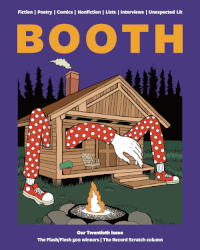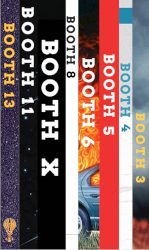by Josh Wilker
I started writing about my childhood baseball cards a little over a decade ago out of desperation. I didn’t have a job, and my money was running out, and the novel I purported to be working on was dying of pretentiousness and exhaustion. Writing about baseball cards didn’t solve any of those problems. But there was some life in it, at least. Over the years it has grown into a practice of sorts, or maybe it’s a hobby, like building ships in bottles, who knows, but either way it seems to help keep me from completely unraveling. The cards, those faulty unpredictable conduits to a long gone childhood and a rangy colorful world that’s otherwise inaccessible to me in my everyday life, remain a mystery to me. They make me think of Fuckhead’s words near the end of “Emergency,” Denis Johnson’s story about aimlessness and visions in the 1970s: That world! These days it’s been erased and they’ve rolled it up like a scroll and put it away somewhere. Yes, I can touch it with my fingers. But where is it?
Mickey Rivers, 1976
By the time I came into possession of this 1976 card of Mickey Rivers bracing for the impact of a falling piano, he had been traded to the Yankees along with Ed Figueroa in exchange for Bobby Bonds. I guess you could say that the falling piano was the fate of continuing to toil with the Angels. Mickey Rivers darted away and let Bobby Bonds take the hit. Rivers lasted three and a half seasons with the Yankees, and in each of his three full seasons the Yankees played in the World Series, winning it in 1977 and 1978. Rivers got plenty of credit for that run, in part because of a lack of understanding in the baseball world at that time that the most important element in scoring runs is getting on base. Rivers was considered the dynamic catalyst of the Yankees’ offensive attack because he generally produced a high batting average and stole bases. However, despite batting at the top of one of the better lineups in the league, Rivers never topped 100 runs scored for a season for the Yankees (and in two of his three seasons he didn’t even get close), an outgrowth of his inability or perhaps unwillingness to draw walks. The sportswriters of the day didn’t notice this deficiency, voting him third in league MVP balloting in 1976, eleventh in 1977, and (most incredibly of all, considering his .265 batting average and .302 on-base percentage that year, numbers that were inferior that season to those of, for example, Duane Kuiper, Bob Bailor, and Mario Guerrero) twenty-fifth in 1978.
The other night ESPN Classic replayed the game that got Rivers and the Yankees to the first of the three straight World Series: the fifth game of the 1976 American League championship series with the Royals. Before the famed riot-sparking home run by Chris Chambliss in the bottom of the ninth, Rivers keyed an early rally by slapping a base hit into centerfield. I’d forgotten how unusual Rivers looked and moved.
“What’s wrong with him?” my wife asked.
We were watching him strut-limp back to first after rounding the bag. He seemed like he’d been assembled in a rush from spare parts, long bow legs springing from a tiny torso, a weird jaunty lean to his body, as if he was suffering from a running cramp. His mouth was motoring.
“He was a character,” was all I could say to my wife by way of explanation.
While my ill will toward the Yankees hasn’t abated since I was a kid (with the possible exception of the benign Steve Balboni years), I do find that time, along with that always questionable eroder of clarity, nostalgia, has allowed me to become less specifically resentful of some of the Yankee players on the 1970s teams. I loathed Mickey Rivers, for example, mainly for the possibly apocryphal parts he played in two terrible Red Sox moments (somewhere, somehow, I got the idea that A: he teamed up with Graig Nettles to separate Bill Lee’s shoulder during a 1976 brawl, and B: in a late October game two years later, the 163rd contest for the two teams playing, he produced and passed along a bat of dubiously powerful qualities to one weak-hitting Yankees shortstop just after said shortstop had broken his own bat and just before he popped an improbable home run over the Green Monster). Now, however, I can’t help but get a chuckle out of Mickey Rivers. My 10-year-old self would glare at me as a traitor for saying this, but the 1970s would have been a little poorer without a guy willing to comment on the physical appearance of another major leaguer (Danny Napoleon) by saying, “He’s so ugly, when you walked by him, your pants wrinkled. He made fly balls curve foul.”
* * *
Don DeMola, 1975
In 1970, at the age of seventeen, Don DeMola won the Carl Yastrzemski award, given to the best high school baseball player in Suffolk County, Long Island. The Yankees drafted him and shipped him to their Rookie League farm club in Johnson City, Tennessee, the first of three minor league stops in two years before the Yankees released him in April of 1972. This 1975 card doesn’t offer any reasons for this decision, which is illustrated by the use in the 1972 line in DeMola’s career major and minor league record by the always mysterious stat-less listing: Not In Organized Ball.
It took exactly nine months beyond the reach of numbers, like some kind of second embryonic passage, before Don was signed in January 1973 by the Montreal Expos. Back among the organized, Don sped up through the Expos system and within a couple years reached the big leagues and made it onto a baseball card, this 1975 offering, his first and second-to-last cardboard incarnation, which references Don’s rare skill: “Don’s best pitch is a fastball which ‘smokes.’” His minor and major league strikeout totals, which in most years hovered near the elite one-strikeout-per-inning mark, also attest to the wonders inside the seemingly normal arm he holds out toward the viewer on the front of the card. His small smile and the reaching arm ending in a loose fist make Don DeMola seem like a friendly, generous guy, someone who wants to share a handful of M&Ms with you.
Others among the upper echelon of smoke-throwers do not generally give off such an approachable aura, but Don DeMola seemed like somebody who wouldn’t mind if you just called him up one day to chat. This approachability, if it ever was fiction and not fact, has become a reality in the present, at least in terms of Don DeMola’s online presence. On Don DeMola’s website, you can contact Don, who proudly identifies himself as a Montreal Expos pitcher, to receive baseball skills instruction. Also, if you live in Suffolk County, you can have Don come over to your house to install an entertainment system. And that’s not all. When arm trouble curtailed Don’s career as a flamethrowing major leaguer, Don went into the fur business, and this facet of his life is also represented on his website in the form of an offer by Don to get you up to speed on the most effective strategies in the fur-buying and fur-care game. Finally, Don offers tips on how to get rich and live your dream life. “I’d like to share a few secrets with you,” Don says. “Simple truths that have helped many people create a life of wealth, freedom and abundance.”
* * *
Dick McAuliffe, 1974
Here’s the featured player on the only glove in my childhood home with a signature embedded in it. It belonged to my brother. I always found this signature and the glove itself a little mysterious, because at almost exactly the same time I started coming awake to baseball, Dick McAuliffe was disappearing. It gave my brother’s glove a somehow disquieting connection to the distant past. Dick McAuliffe was not completely unknown to me but was instead a weird, unsettling flickering in my consciousness. I had this 1974 card of Dick McAuliffe and no others, but the card and my other few cards from 1974 (the year of my first shallow foray into buying packs of cards) always seemed out of place with the rest of my cards, in part because there were so few of them in my collection and in part because most of the players shown on them still seemed to be rooted in an earlier, more cleancut era than the one that exploded through the more colorful cards that Topps featured for the remainder of the decade. I’m attracted to the classy understatement of the 1974 cards now, but when I was a kid I think I was a little creeped out by them, as if they were akin to one of those shadowy, toyless rooms at your grandparents’ house that no one really hangs around in anymore. If you ever ended up alone in one of those rooms you’d linger for a little while just to kind of scare yourself a bit, standing there on a self-made dare and looking at the dusty antique lamp and the leather-bound books and the black and white photos of your uncles as crewcutted little Rockwellian boys with melancholy eyes, but then before long you’d go sprinting back downstairs to where everyone was sitting around eating cheese and crackers and intermittently monitoring a football game that no one really cared about. This is the primary function of sports, isn’t it? To serve as comforting background chatter when you race in from dark quiet rooms with your heart pounding? Anyway, the 1974 cards were like those dark quiet rooms to me, sort of, or at least some of them were, like this Dick McAuliffe card. Who was Dick McAuliffe and what was he doing on my favorite team and on my brother’s glove? And where did he go? And why had I never heard about him anywhere despite the long run of good seasons listed on the back of his card?
We’re all just passing through.






